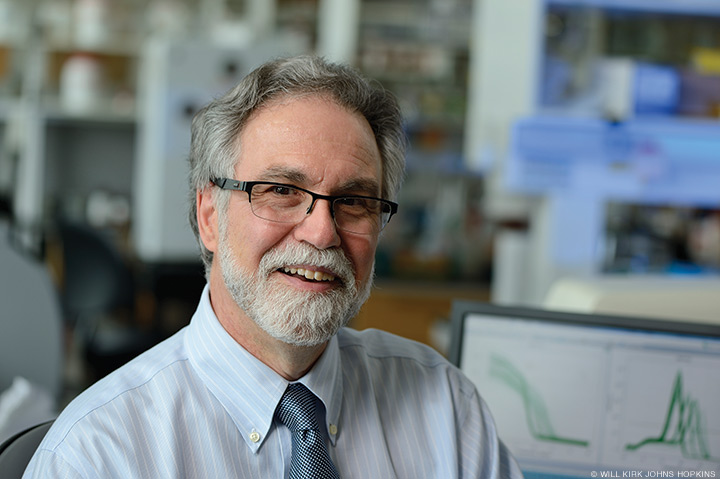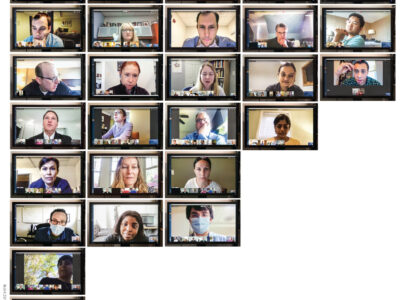
How decades of dogged research led to one of medicine’s most prestigious prizes.
Looking back at his time studying genetics in Penn’s MD/PhD program, Gregg L. Semenza M’82 Gr’84 admits to his “share of setbacks.” After one of his experiments failed, he switched labs, joining a Children’s Hospital of Philadelphia lab led by Elias Schwartz, then the director of hematology. Later, after taking “about a year” to sequence a gene for another experiment about blood disorders, he realized “it turned out to have the same mutation as the previous individual who was studied in the lab, which meant that it was likely that there was some contamination.”
But, he quickly adds, “you learn more when things fail than when they succeed, because you have to think harder about what you’re doing.” By the time he left Penn, Semenza had identified a novel form of beta thalassemia, a genetic disorder that impairs the delivery of oxygen to parts of the body.
Semenza has dealt with—and overcome—impediments ever since. Now, he has reached a pinnacle of his profession. In early October, Semenza won the 2019 Nobel Prize in Physiology or Medicine. A professor of genetic medicine and researcher at Johns Hopkins University, Semenza shares the award (and $913,000 cash prize) with fellow physician-scientists William G. Kaelin Jr. and Sir Peter J. Ratcliffe “for their discoveries of how cells sense and adapt to oxygen availability,” the Nobel Assembly at the Karolinska Institute wrote.
“I enjoy doing research,” Semenza says. “We just ask questions and get answers, and those answers tell us a little bit more about what we’re studying. … After a while, you can look back and see how far you’ve come.”
Semenza’s groundbreaking discovery of the HIF-1 protein, which plays a primary role in the production of red blood cells under oxygen-poor conditions, could have broad implications in the treatment of a variety of illnesses. Because cancers often overproduce HIF-1 during their growth, developing drugs that inhibit HIF-1 production has the potential to become a powerful tool to treat cancer.
Currently, HIF-1 inductors (drugs that promote the creation of HIF-1) for chronic kidney disease and anemia are in clinical trials. “These drugs are just pills that can be taken by mouth,” Semenza says. “They’ll potentially have a large impact on people with chronic kidney disease and maybe other types of anemia.”
Born in Queens and raised in nearby Westchester County, Semenza wasn’t particularly interested in science as a youngster. He is quick to credit his high school biology teacher, the late Rose Nelson, for sparking his fascination with biology, which he says was like “a light going on.”
Following his time at Penn, Semenza headed to Duke University for pediatric medical training and then to Johns Hopkins, where he continued his nascent research into red blood cell production and regulation, earning two prestigious grants typically reserved for researchers higher up in the academic hierarchy. “I was very fortunate,” says Semenza, who credits Hopkins mentors like John D. Gearhart for helping him navigate the grant process.
Now at Penn, Gearhart recalls that from his first interactions with Semenza in the late 1980s, “it was clear that he was very smart, very focused, with excellent work habits.” That assessment never changed. “Trust him [and] he’ll produce—always with good ideas, insight, creativity, and high standards,” Gearhart says.
Semenza’s research ideas were bold, but he never wavered in confidence. “One of the criticisms that people make of young investigators is that the work that they propose is too ambitious,” he says. “I received this criticism on one of the [grant] applications. We had already done half of the work by then. The reviewers weren’t ambitious enough.”
Semenza would be vindicated in 1995, when he published his first HIF-1 findings, beginning his 24-year journey to the Nobel. “When we wrote our manuscript reporting the discovery of HIF-1, we submitted it to … top-tier journals, and they did not find it to be of sufficient interest to warrant publication,” he recalls. It was eventually accepted and has since been cited over 5,000 times.
Now, he plans to keep doing this kind of research for “as long as I’m able,” he says. “This is something I really enjoy—and it gives me a sense of purpose.”
—Logan Chipkin C’15




